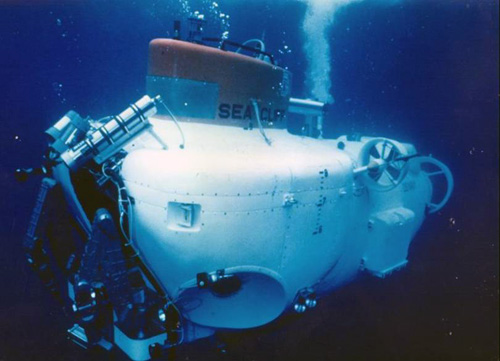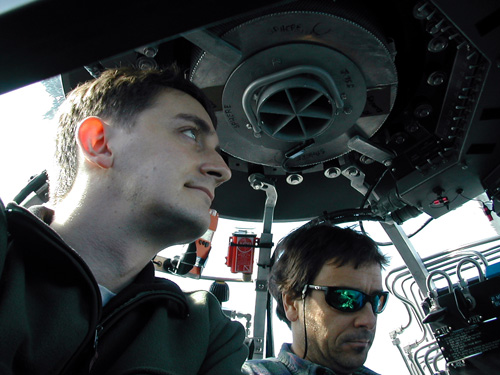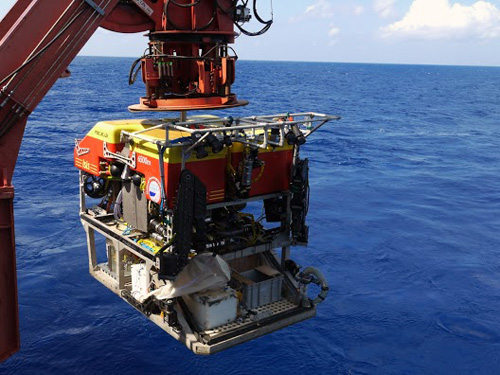Monday 18th February
One of the routine tasks as Principal Scientist is to produce the "daily plan", which determines what we will be doing with the ship over the next 24 hours. The goal is to avoid "idle" time while ensuring that we get the data and samples that we need, and the plan is frequently revised as conditions unfold. Consequently, the task is sometimes like trying to complete a jigsaw puzzle whose pieces are continually changing shape.
We have a fixed rendezvous with some visitors early tomorrow morning (and whose identities I will be able to disclose later this week), which means that our activities today need to fit into a particular pattern, to avoid being either too early or late at that rendezvous.
This morning we were actually ahead of schedule, thanks to the efficiency of the hydrography team. The time gained allowed us to take advantage of a "target of opportunity", and collect some extra geological samples from the base of Mount Dent with a rock dredge. I am grateful to the technical staff and deck crew for being able to prepare and deploy an unexpected piece of equipment at last-minute notice.
As an aside, today we have been discussing the news that the US research submersible Alvin is nearly ready to return to service following a $41 million refit (and Alvin's first science trials will be here, at the Von Damm Vent Field, in May). This has reopened a long-running debate among team members about HOVs (human-occupied vehicles) and ROVs (remotely operated vehicles) in deep-sea research.
HOVs played a key role in research at deep-sea vents for several decades, and those of us aboard who have been fortunate to dive in them cherish the experience. I won't forget looking out of a submersible porthole at 2.2 km depth and seeing a chimera fish hanging in water just outside, seeming to meet my gaze with a huge dark eye. I was suddenly struck by a realisation that although less than a metre separated us, we were worlds apart: mine was one of light and air, and theirs one of darkness and crushing pressure.

DSV Sea Cliff (photo: August Sigur, US Navy)
My first dive to deep-sea vents also left me with an indelible impression of the patchiness of the conditions and life around the vents. Investigating patchiness and understanding its consequences has been a theme in my research at vents, and perhaps I owe that perception to being there physically and observing the environment directly through a porthole.
But opportunities for scientific dives in HOVs have diminished: DSV Sea Cliff, which took me on my first journey into the deep ocean, has long been decommissioned. The Johnson Sealink submersibles, which enraptured me with the immersive view from their acrylic front sphere, are no longer available for scientific use. My current PhD students are understandably eager to dive in an HOV, but perhaps less likely to do so.

Johnson Sealink submersible (and a more youthful author)
But while HOVs have an assured place in the history of research at deep-sea vents, are they necessarily the best tools at present and for the future? The recent rebuild of the Isis ROV cost ~1% of the Alvin refit. Yet Isis can collect the same samples and data, and actually dive deeper and stay for longer. When Alvin comes here in May, it will not yet be able to reach the deeper Beebe Vent Field where we have started diving.
For me, "bottom time" (time spent working on the seafloor) during an expedition is the bottom line: we are here to investigate the deep ocean, so that's where we want to spend as much time as possible. Because of battery limitations, Alvin dives last for ~10 hours including ascent/descent, which means that only ~6 hours in every 24 can be spent working on the seafloor at the depth of the Von Damm Vent Field. So the maximum achieveable "bottom time" in a week would be ~42 hours (25% of expedition time).
ROV dives, however, are not limited by batteries, because power is provided via the vehicle tether. During our first week at the Von Damm Vent Field, most of our dives were more than 20 hours each in duration, and the Isis ROV clocked up 121 hours of "bottom time" (72% of expedition time).

Isis ROV (photo: Adrian Glover)
ROVs such as Isis can also be manoeuvered with great precision compared with larger HOVs. This capability has allowed us to develop video survey techniques for "getting the bigger picture" at deep-sea vents, which extend our perception beyond the view from portholes. We hope to apply those techniques at the Beebe Vent Field during our next dive tomorrow.
I'd still jump at a chance of using the new Alvin, and I think the deep ocean is large enough for both types of vehicle to work together. But the numbers do highlight the superb efficiency of ROVs such as Isis for deep-sea science; I think they offer a deeper, longer, cheaper option at present. And philosophically, when we are in the ROV control centre, our minds are on the ocean floor. In the 21st century, it doesn't really matter where our bodies are.
